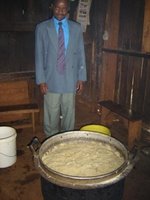So Little Time, So Much To Learn! - School Feeding Programs
Elizabeth Baglole
GCI Participant
School Counsellor, Western School Board
March 14, 2006
How can one truly understand the essence of a people, the motivations of a people to create for themselves a life and an existence filled with purpose and meaning? Yet again, how can one who is exposed to that essence and existence truly share that with another who lives thousands of miles away in a land of privilege? That is the task given to a group of P.E.I. teachers who are presently in Kenya for three weeks preparing materials for Prince Edward Island students.

As part of that team, I am struck by the joyful spirit of the people here. Everywhere we have gone the people are SO HAPPY to have us visit and to share information about their lives. We have visited more that 10 schools so far and are struck by the joy in the faces of the children. Their laughter, at hearing us speak and seeing their pictures in our digital cameras, is like none other I have heard.
How can there be such joy when as many as 50% of these children come from homes that live below the poverty line (about $1.00 per day,). How can children concentrate on their school work and achieve in school when all they can think about is the emptiness in their stomachs and when they will once again have a meal? How can parents be expected to pay for the costs associated with sending their children to school, like uniforms and school supplies, when there is not enough to feed their families? Getting a basic education, children’s only hope in breaking the cycle of suffering; is made virtually impossible without daily sustenance to help them focus on their studies.
Several schools that we visited understand the importance of food to a student’s livelihood and success. Over the past three years Kihuiti Secondary School has improved school attendance and school performance by offering a Feeding Program. Over that period, they have increased their enrollment by 25%; in spite of the fact that, as a secondary school, education is no longer free as it is during the primary years, and students must pay tuition fees in order to attend. That 25% represents the 1 in 4 students who would not normally be able to attend school due to poverty.
Kihuiti has been able to offer their Feeding Program to its students since the construction of a dining hall on their school site three years ago. The building was constructed using a portion of school fees previously collected and is used as a multi-purpose hall by the community for the hosting of special events such as weddings and presentations by political representatives.
Some students walk as much as 8 kilometers to school, leaving as early as 5:45 am to be at school for 7:30 am to prepare for the first class at 8:30 am. As they may not have had much, if anything, to eat before setting out from home, the Feeding Program has become an important source of nutrition for many students. Morning tea is served at 10:00 am and a lunch at 12:40 pm that usually consisted of maize, beans, bananas and once a week "ugali" (see photo to right) and cabbage, a traditional favorite. The cost of this program is covered within the fee structure, at a cost of 1000 KS ($17.00 Canadian) per term; and for those parents who cannot afford to cover the cost for their children, the school accepts payments in "kind". Because the school operates a small "shamba" (farm) on the property with 2 bulls, 2 pigs, several goats, and 1000 coffee plants; the parents, if unable to pay, may contribute livestock, maize, corn or a contribution of work, if available, on the farm or dining hall in place of the fees. Profit from the sale of livestock and produce; both from the farm and Form 4 (Grade 12) garden plots, a part of their Agricultural Class, goes to the Feeding Program.
pm that usually consisted of maize, beans, bananas and once a week "ugali" (see photo to right) and cabbage, a traditional favorite. The cost of this program is covered within the fee structure, at a cost of 1000 KS ($17.00 Canadian) per term; and for those parents who cannot afford to cover the cost for their children, the school accepts payments in "kind". Because the school operates a small "shamba" (farm) on the property with 2 bulls, 2 pigs, several goats, and 1000 coffee plants; the parents, if unable to pay, may contribute livestock, maize, corn or a contribution of work, if available, on the farm or dining hall in place of the fees. Profit from the sale of livestock and produce; both from the farm and Form 4 (Grade 12) garden plots, a part of their Agricultural Class, goes to the Feeding Program.
Administration, at Kihuiti, has noted that since the inception of the Feeding Program; there have been fewer discipline problems, as students are generally in better humour, performance of students has improved, as a result of improved concentration and productivity, and less absenteeism since students are not sneaking away from school to look for food.
 The formula seems simple. Food attracts hungry children to school. Hungry children are, generally poor. Education empowers poor children and helps to lift them out of poverty. Thus, schools that are able to offer Feeding Programs to their students are not just filling their stomachs, they are offering hope of a better future.
The formula seems simple. Food attracts hungry children to school. Hungry children are, generally poor. Education empowers poor children and helps to lift them out of poverty. Thus, schools that are able to offer Feeding Programs to their students are not just filling their stomachs, they are offering hope of a better future.
GCI Participant
School Counsellor, Western School Board
March 14, 2006
How can one truly understand the essence of a people, the motivations of a people to create for themselves a life and an existence filled with purpose and meaning? Yet again, how can one who is exposed to that essence and existence truly share that with another who lives thousands of miles away in a land of privilege? That is the task given to a group of P.E.I. teachers who are presently in Kenya for three weeks preparing materials for Prince Edward Island students.

As part of that team, I am struck by the joyful spirit of the people here. Everywhere we have gone the people are SO HAPPY to have us visit and to share information about their lives. We have visited more that 10 schools so far and are struck by the joy in the faces of the children. Their laughter, at hearing us speak and seeing their pictures in our digital cameras, is like none other I have heard.
How can there be such joy when as many as 50% of these children come from homes that live below the poverty line (about $1.00 per day,). How can children concentrate on their school work and achieve in school when all they can think about is the emptiness in their stomachs and when they will once again have a meal? How can parents be expected to pay for the costs associated with sending their children to school, like uniforms and school supplies, when there is not enough to feed their families? Getting a basic education, children’s only hope in breaking the cycle of suffering; is made virtually impossible without daily sustenance to help them focus on their studies.
Several schools that we visited understand the importance of food to a student’s livelihood and success. Over the past three years Kihuiti Secondary School has improved school attendance and school performance by offering a Feeding Program. Over that period, they have increased their enrollment by 25%; in spite of the fact that, as a secondary school, education is no longer free as it is during the primary years, and students must pay tuition fees in order to attend. That 25% represents the 1 in 4 students who would not normally be able to attend school due to poverty.
Kihuiti has been able to offer their Feeding Program to its students since the construction of a dining hall on their school site three years ago. The building was constructed using a portion of school fees previously collected and is used as a multi-purpose hall by the community for the hosting of special events such as weddings and presentations by political representatives.
Some students walk as much as 8 kilometers to school, leaving as early as 5:45 am to be at school for 7:30 am to prepare for the first class at 8:30 am. As they may not have had much, if anything, to eat before setting out from home, the Feeding Program has become an important source of nutrition for many students. Morning tea is served at 10:00 am and a lunch at 12:40
 pm that usually consisted of maize, beans, bananas and once a week "ugali" (see photo to right) and cabbage, a traditional favorite. The cost of this program is covered within the fee structure, at a cost of 1000 KS ($17.00 Canadian) per term; and for those parents who cannot afford to cover the cost for their children, the school accepts payments in "kind". Because the school operates a small "shamba" (farm) on the property with 2 bulls, 2 pigs, several goats, and 1000 coffee plants; the parents, if unable to pay, may contribute livestock, maize, corn or a contribution of work, if available, on the farm or dining hall in place of the fees. Profit from the sale of livestock and produce; both from the farm and Form 4 (Grade 12) garden plots, a part of their Agricultural Class, goes to the Feeding Program.
pm that usually consisted of maize, beans, bananas and once a week "ugali" (see photo to right) and cabbage, a traditional favorite. The cost of this program is covered within the fee structure, at a cost of 1000 KS ($17.00 Canadian) per term; and for those parents who cannot afford to cover the cost for their children, the school accepts payments in "kind". Because the school operates a small "shamba" (farm) on the property with 2 bulls, 2 pigs, several goats, and 1000 coffee plants; the parents, if unable to pay, may contribute livestock, maize, corn or a contribution of work, if available, on the farm or dining hall in place of the fees. Profit from the sale of livestock and produce; both from the farm and Form 4 (Grade 12) garden plots, a part of their Agricultural Class, goes to the Feeding Program.Administration, at Kihuiti, has noted that since the inception of the Feeding Program; there have been fewer discipline problems, as students are generally in better humour, performance of students has improved, as a result of improved concentration and productivity, and less absenteeism since students are not sneaking away from school to look for food.
 The formula seems simple. Food attracts hungry children to school. Hungry children are, generally poor. Education empowers poor children and helps to lift them out of poverty. Thus, schools that are able to offer Feeding Programs to their students are not just filling their stomachs, they are offering hope of a better future.
The formula seems simple. Food attracts hungry children to school. Hungry children are, generally poor. Education empowers poor children and helps to lift them out of poverty. Thus, schools that are able to offer Feeding Programs to their students are not just filling their stomachs, they are offering hope of a better future.

0 Comments:
Post a Comment
<< Home